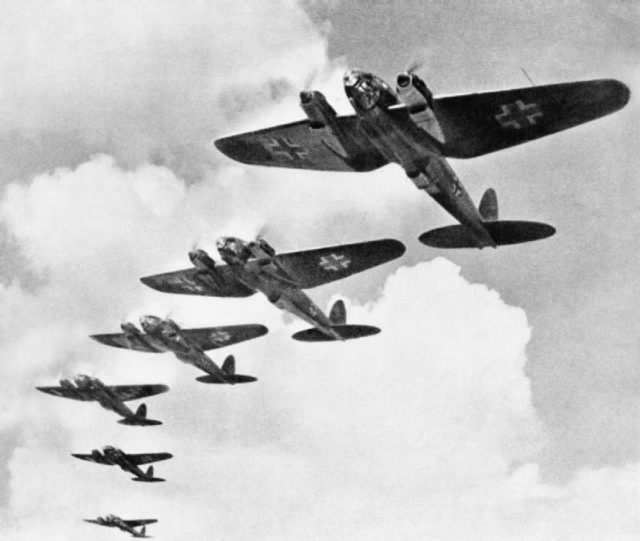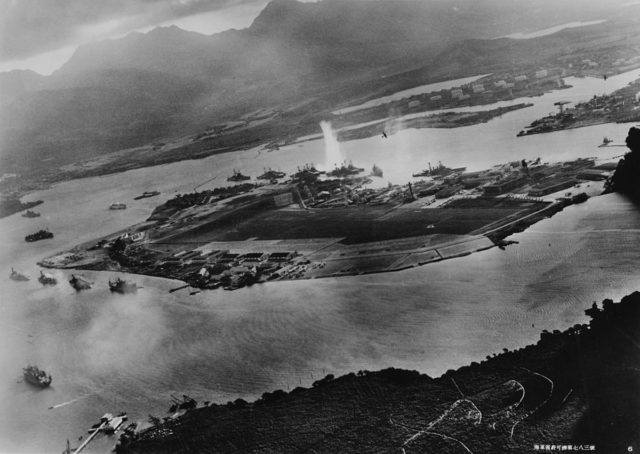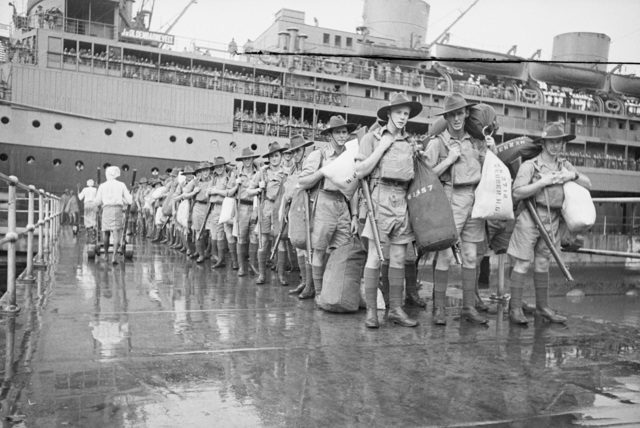To mark fall of Singapore, 15 February 1942 – Alex Kershaw is an author of books on WWII, including the New York Times best-sellers The Bedford Boys and The Longest Winter.
I WAS STUNNED when I saw the battered trunk, plastered with customs stickers, sitting in the center of a living room in Springfield, Massachusetts. I couldn’t believe my eyes when a relative of the superb WWII fighter pilot, Art Donahue, opened the trunk and I then looked inside. Here were the personal belongings of one of the American few – eleven renegade crusaders – who fought illegally in the Battle of Britain: his RAF wings, a scrap of fuselage from a downed German bomber, diaries, logbooks, and long letters sent almost daily to Donahue’s family in St. Charles, Minnesota, throughout 1940-42.
At the bottom of the trunk was the manuscript of a book that Donahue wrote in the spring and summer of 1942. It was titled ‘Last Flight from Singapore’. I carefully read the yellowed, typewritten pages, with Donahue’s scribbled revisions on the flimsy margins, and was awed by the tale this remarkable 29-year-old warrior told. To mark the 75th anniversary of the fall of Singapore, on 15 February 1942, I thought it would be more than worthwhile to revive Donahue’s account of his valiant efforts to defend Singapore from the air.
The story begins in December 1941, a few days before the Japanese attacked Pearl Harbor, which marked the United States entry into WWII – eighteen months after Donahue had first seen combat against the Luftwaffe during the Battle of Britain.

IT WAS A relief that be back in a cockpit rather than in some dingy Gibraltar bar trying to kill time playing darts. The smell of oil, burnished metal, and leather had always made Art Donahue feel better. He was delighted that early December of 1941 that he was keeping his flying skills honed through low-level patrols along the Spanish coast with 258 Squadron, based in Gibraltar. And there was always the off chance that he might run into easy prey: German Focke-Wulf Condors flying out of Cadiz to attack Allied convoys in the Atlantic.
On December 7, 1941, Donahue returned to his billet in Gibraltar after watching a movie. Before turning in for the night, he switched on his radio. At 11 p.m., he heard his first news report on the bombing of Pearl Harbor. Some of his fellow Americans serving in the RAF were deeply shocked, but they also celebrated the news of the Japanese attack until the early hours because it signaled the end of American neutrality.

In a letter I found in Donahue’s trunk, I read his reaction to the Japanese attack as he described it to his parents in Minnesota: “For the first few hours after I heard the news of the attack on Hawaii I seemed to take it quite casually. Then when it really began to sink home I found myself more really and truly mad at the Japs than I have ever been able to be toward the Germans—with all their crimes. Somehow, the fact that it’s your own people who have been attacked seems to make a tremendous difference.”
Donahue was in fact so enraged that he decided to apply for a posting to the Far East, but before he could do so he and 258 Squadron received orders to fly part of the way to a new posting which was being kept secret. Just before Christmas Donahue set out on a long journey across North Africa. In Nigeria, early in the New Year, he learned of his final destination—Singapore, garrisoned by some 70,000 front-line troops, including thirteen British and six Australian infantry battalions.

Donahue could not have been more pleased: now he would have a chance to strike back at the Japanese, who had bombed Singapore for the first time on 8 December. On January 29, 1942, 258 Squadron finally arrived in the British colonial outpost, finishing its marathon journey aboard a transport ship. There was no time for rest. Within forty-eight hours, 258 Squadron was in action, defending the island from Japanese dive-bombers. The squadron faced overwhelming odds and had to operate in terrible humidity without adequate fuel supplies, spare parts, or reserves of ammunition.
By February 15, barely a fortnight later, 258 Squadron had been reduced to a few bone-tired pilots and battered planes. Early that morning, Donahue led a search for Japanese invasion barges that had been spotted heading toward the mainland of Singapore. Flying as Donahue’s Number 2—his wingman—was British pilot Terrence Kelly. “You know what I need?” Donahue had asked Kelly just a few days before. “Just a nick. Just something that’ll get me home to an American squadron now we’re in the war.”
Donahue, Kelly, and four other pilots from 258 flew north toward the port of Pladjoe. Oil wells nearby had been set alight to prevent the Japanese from exploiting them. “The smoke rose for several thousand feet before, catching some air current, it spread away like a sign-post, a huge black swathe across the sky pointing to the target and we flew under it as cover,” recalled Kelly. “It was a strange atmosphere—above the queer black cloud, below the darkened jungle broken only by the turgid brown swathes of many rivers which made the Moesi delta.”
Donahue and Kelly spotted a small group of boats and attacked. But then they learned that their victims were not part of the invasion armada that had been reported. “I kept close to Donahue and he was puzzled too, looking this way and that,” recalled Kelly, “and then we came upon the barges.”
Donahue had never seen so many enemy troops so vulnerable to attack: “Often I had machine-gunned German soldiers, sailors, or airmen on the ground or in ships, but always where they either had a little shelter or concealment, or at least could scatter and throw themselves flat. These fellows had no shelter or concealment except the thin sides of their boats, no better than paper for stopping our bullets, and they were jammed in so tight that they couldn’t scatter or throw themselves flat or do anything except just sit up and take it.”
Donahue came in low, around a hundred feet above the water. He made a last check for Japanese fighters—Navy Zeros. The barges loomed larger in the amber glow of his reflector sight. He moved his thumb over to his firing button, wanting to send his first bullets a little high, knowing they would dip. Then he opened fire: “There was an abrupt shattering roar from the guns in my wings and then eighty ghostly white tracers snaking out ahead eagerly, toward the boat and its helpless passengers. They would know nothing more.”
Donahue’s wingman, Terrence Kelly, had the perfect view of the ensuing slaughter: “I probably saw the effect of Donahue’s attack much better than any of my own because I had fallen astern behind him waiting my turn and with nothing to do and not much to think about but watch. I really don’t believe Donahue missed a barge, his guns raking the convoy from head to stern. The bullets made an unforgettable pattern. There was a pincushion of water ahead of the nearest barge which moved along so that as the bullets raked through a barge what one saw was the pinpoints of light in the barge itself.”
Donahue had lost too much altitude, so he pulled the stick back and corrected, aiming at a barge farther in the distance. His aim was again perfect, its effect devastating. Tracers tore into the bodies of twenty tightly packed Japanese soldiers. He could see their faces as they died. Then he began to bank and turn away to attack another barge.
A 20 mm anti-aircraft shell hit Donahue in the calf of his left leg. He looked down in shock at two holes. “One [was] small and round,” he recalled. “The other [was] a gaping sort of thing an inch wide by a couple inches long, with raw red and blue flesh and muscle laid open, before the blood welled up and started streaming out.”
Donahue turned away sharply from the anti-aircraft fire toward an endless green carpet of the jungle. The shock began to abate and his instinct for survival kicked in. He was almost a hundred miles from his base. He had a tendency to black out when he began to bleed. Could he stay conscious long enough to get home?
A few minutes later, Donahue began to feel light-headed. He grabbed his trouser leg above the wound and tried to twist it to form a tourniquet. But still his ruptured veins spurted and blood collected in a bright red pool in his heel rest, a metal trough underneath his rudder pedal. He looked at his altimeter, spattered with pieces of his flesh, and knew that if he faded away for even a couple of seconds he would crash. He gritted his teeth, his ears ringing, dots filling his vision.
I mustn’t faint, I mustn’t faint!
Donahue’s vision became blurred. He began to panic.
I am fainting—I mustn’t faint—I am fainting!
The seconds passed slowly. Donahue realized he was still awake. He could hear Hurricane’s Rolls-Royce engine purring. He wondered whether he should crash-land, and whether to shut down the engine before he did so. Then he had a smart idea: he would keep himself awake with extra oxygen. He let go of the stick, reached to his instrument panel, and increased his oxygen supply. Although flying just a few hundred feet above the jungle’s canopy, he was soon breathing enough oxygen to stay wide awake at forty thousand feet. Donahue still grabbed his torn trousers with one hand. He opened his throttle, letting go of the stick again for a second or two, and then checked his wound. He was still losing blood.
There was only one thing for it. “It seemed easy,” he later recalled. “I let go [of] the hold I had of my trouser leg above the wound, grabbed up the torn cloth right over it, twisted it, and then jammed my gloved fist, knuckles first, as deep as I could into the large hole, and held it that way.” Donahue almost blacked out. He tried to breathe more slowly so he could stay conscious. His oil and temperature gauges showed normal. They had not been hit. His reserve fuel tank was still full. Constantly, he turned his head, looking out for Japanese Navy Zeros, flying as low as he could above the trees.
The jungle finally gave way to rice fields and waterways—he was getting close to his home base. He looked down at his wound and saw that it had stopped bleeding: “The red rivulets down my leg and shoe seemed to be stationary, and the puddle of blood in the heel rest was no longer bright but dark, which meant that there couldn’t be any fresh blood on it. The pain, which never had been agonizing, had settled into a heavy ache as from a badly bruised muscle. My hopes of making it really soared.”
Donahue flew south, unable to recognize landmarks because they were obscured by smoke from bombings and many fires. If only he could spot a familiar railway line to lead him home. The weather had now closed in and he had to concentrate hard to avoid several rainstorms. Suddenly, there were the blessed rail tracks. Donahue banked slightly and followed them. And then there it was—his airfield. Now he would have to land with one hand: he dared not pull his gloved one out of the hole in his leg.
Donahue came in low, slowly wagging his wings to show that he was hurt. He let go of the stick for a second to lower his wheels for landing and then he eased off the throttle. Still too much speed. He used his left elbow to throttle back even more. Then the wheels hit the ground and he bounced violently for a hundred yards. “The feeling of triumph at having made it safely made the bad landing seem inconsequential! I felt almost boisterous as I taxied up to the watch office.”
The surviving pilots and ground crew of 258 Squadron ran out to Donahue’s plane and helped him out of the cockpit. A fellow officer dressed his wound, and he was rushed to the nearest aid station. Donahue suddenly feared that if he was hospitalized he would inevitably become a prisoner of the Japanese, who in a matter of hours would seize all of Singapore.
To Donahue’s relief, after a quick call was put through to his squadron, he was carried to an ambulance and driven back to his base. “A Lockheed bomber bound for Java was held up waiting for me at Squadron Leader Thomson’s intercession,” recalled Donahue. “Two hours later I was safely in bed, three hundred miles from the fighting zone, in the Dutch Military Hospital of Bandoeng, a beautiful city in the mountains of west central Java. I had all that I promised myself—a bed to sleep in, with clean sheets, and the prospect of breakfast in bed in the morning! In addition, I had a very pretty nurse to look after me.” Donahue was lucky indeed. It is believed that the Lockheed bomber that arrived in Java with him aboard was the last flight out of Singapore before it fell to the Japanese. At 17.15 that day, 15 February 1942, as Donahue lay in a hospital bed in Java, Lieutenant-General Arthur Percival, commander of the Singapore garrison, formally surrendered to the Japanese. Around 80,000 Allied troops became prisoners of war – in Churchill’s words the “largest capitulation” and “worst disaster” in British military history.
ART DONAHUE’S thrilling account of the last hours of Singapore, lyrically described in the yellowing first draft manuscript that I found in his trunk several decades later, was published in hardback for the first time in 1943. Donahue never got to read it. After recuperating from his wounds, he joined 91 Squadron back in England as a flight commander and by August 1942 had become 91’s acting commanding officer, the first and only American in the RAF’s history to lead an all-British squadron. On 30 August 1942, Donahue failed to return from a Channel sweep over Ostend. An obituary in the London Times noted that Donahue “had joined the RAF in spite of considerable difficulties, personal and otherwise, not from any wish for adventure or personal advancement, but rather in the spirit of a crusader who had no illusions about what lay before him, and had counted the cost…He was a very gallant gentleman.”
Author: Alex Kershaw
THE FEW book on Amazon